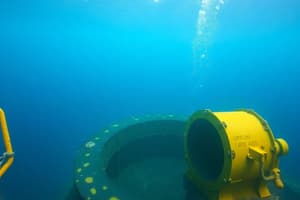Podcast
Questions and Answers
During the subsea spool tie-in operations, what primary factor contributed to the crane hook striking the diver's helmet?
During the subsea spool tie-in operations, what primary factor contributed to the crane hook striking the diver's helmet?
- Inadequate communication between the dive supervisor, crane operator, and diver. (correct)
- The diver's failure to maintain a safe distance from the pipe handling frame (PHF).
- The crane operator's lack of experience in subsea lifting operations.
- The unexpected shifting of the seabed due to strong underwater currents.
What immediate action demonstrated effective emergency response following the crane hook striking the diver's helmet?
What immediate action demonstrated effective emergency response following the crane hook striking the diver's helmet?
- Diver 2 promptly assisted Diver 1, ensuring no injuries were sustained, and both divers returned to the bell safely. (correct)
- The crane operator immediately shut down all operations to assess the damage.
- The diving team inspected the crane hook for potential defects.
- The dive supervisor immediately reported the incident to IMCA.
What role did the diver's helmet play in mitigating potential harm during the incident?
What role did the diver's helmet play in mitigating potential harm during the incident?
- The helmet's reflective coating enhanced visibility, allowing the crane operator to see the diver.
- The helmet's buoyancy control system allowed the diver to quickly move out of the path of the crane hook.
- The helmet's advanced communication system alerted the dive supervisor to the impending danger.
- The helmet absorbed the impact, preventing injury to the diver. (correct)
Besides ensuring adequate distance, what technological enhancement could improve safety in subsea lifting operations with poor visibility?
Besides ensuring adequate distance, what technological enhancement could improve safety in subsea lifting operations with poor visibility?
What procedural change could most effectively prevent future incidents of this nature?
What procedural change could most effectively prevent future incidents of this nature?
Flashcards
Incident Summary
Incident Summary
Crane hook struck a diver's helmet during subsea spool tie-in operations due to misjudgment of hook position.
Causes of incident
Causes of incident
Inadequate crane pennant length and poor visibility.
Prevention Measures
Prevention Measures
Ensure adequate distance between divers/crane hook; enhance visibility aids; reinforce communications; minimize assumptions.
Enhanced Visibility Solutions
Enhanced Visibility Solutions
Signup and view all the flashcards
Communication Importance
Communication Importance
Signup and view all the flashcards
Study Notes
- During subsea spool tie-in operations, a crane hook struck a diver's helmet.
What Happened
- Divers were working on the seabed in poor visibility during subsea spool tie-in operations.
- After landing the pipe handling frame (PHF), the Diving Supervisor ordered the crane operator to lower the crane hook to the seabed to disconnect rigging.
- The crane operator reported no weight on the crane wire, and the Diving Supervisor assumed the hook was on the seabed.
- The supervisor instructed the diver to disconnect the PHF from the crane.
- While the diver was disconnecting the rigging beneath the PHF, the crane hook hit the diver's helmet.
- The diver was uninjured and immediately returned to the dive bell, and the dive was aborted.
- The diver's reclaim helmet was damaged beyond repair upon later inspection
- The helmet's integrity was maintained, proving the diving helmets' durability.
What Went Right
- Diver 2 assisted Diver 1, confirming no injuries.
- Both divers returned to the bell safely.
- Divers and the crane block had locating beacons for accurate tracking.
- Procedures, lifting plans, and Job Hazard Analysis (JHA's) were followed.
- Protective equipment worked, and the diver was uninjured due to the helmet absorbing the impact.
What Went Wrong
- When lowered for PHF rigging disconnection, the crane hook rested on the PHF's top beam resulting in a 'no weight' reading.
- It led the crane operator to assume the hook was on the seabed.
- As the diver approached the disconnection point, the hook slipped off the beam and hit the side of the diver's helmet.
What Was the Cause
- The crane pennant/stinger was an inadequate length and didn't provide enough distance between the divers and the crane hook.
- Poor-visibility hindered the ability to accurately observe the position of the crane hook.
Lessons and Actions
- Ensure adequate distance between divers and crane hook: Use a sufficiently sized crane pennant/stinger to maintain a safe distance between the divers and the crane hook, especially in limited visibility.
- Enhanced visibility aids and monitoring: Use alternative methods such as additional locating beacons, underwater cameras, or sonar in low-visibility environments to better track the crane hook's position.
- Reinforce communications, challenge assumptions: Minimize assumptions about equipment position.
- Clear communication and confirmation procedures between the dive supervisor, crane operator, and divers should be reinforced to ensure all parties are fully aware of the equipment's location at all times.
- Updated project procedures to specify minimum pennant lengths for different operations.
- Conducted pre-operation inspections of all rigging and lifting equipment including crane hooks and pennants, to ensure they meet safety standards.
- Updated the Job Hazard Analysis (JHA) to incorporate lessons learned regarding safe distances, visibility, and communication requirements for subsea lifting operations.
Studying That Suits You
Use AI to generate personalized quizzes and flashcards to suit your learning preferences.




